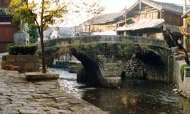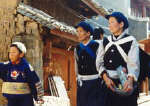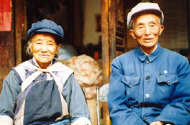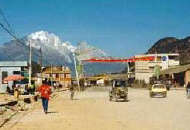Deep in the far north-west of China's Yunnan Province lies an ancient town whose history began long before the Mongol invasion led by Kublai Khan (Yuan Dynasty 1271-1368)."The inclusion of southern China in 1279 made the Mongol Empire the largest the world has ever seen" (Lonely Planet's China 5th Ed. 1996:719)
The inhabitants of this remote region are primarily Naxi (Narshi), the descendants of Tibetan nomads. This is immediately recognisable as their faces are rather oblong-shaped and their skin is tanned and weathered from the extremes of temperature experienced at an altitude of 3,000 metres. Their kinship system is matriarchal making the women visible on the streets of the ancient town as they attend to daily activities and chores.
When I left Kunming for Dali I had two days maximum to spare. Dali was nice, with fantastic mountain-scapes and incredibly picturesque scenery, yet it seemed to be lacking something. Its innocence had gone, a resistance to Western and modern ways had not succeeded – it lacked isolation. I had heard of, and had seen a documentary on Lijiang before I left for China but I did not think I could get there because I was already covering such a large distance in a mere two weeks. As the urge to make the six hour bus trip between Dali and Lijiang grew I found through inquisition that it was possible to fly back from Lijiang to Kunming, therefore saving 24 hours of bone-jarring bus time. This clinched it for me!

 Lijiang, old town
Lijiang, old town
Lijiang is half new town and half old town. The new town is simply another dusty Chinese city, the old town is where backpackers congregate and the increasingly ubiquitous tour passes. The old town sits quite apart from the new, with no cars, trucks, nor motorbikes, and only the occasional pushbike is led through the old town's stony pedestrian streets.
Yellow Hill Section is the name of the side of the mountain on which the town rests, and directly opposite this at 5,500 metres, just 30 kilometres away, is Jade Dragon Snow Mountain. Its stunning peak is annually snow-covered and on a clear blue-sky day, like the day I arrived, you can't help but think that you have died and gone to heaven.
As you make it past the entrance of Lijiang's old town you immediately get an overwhelming feeling of historical significance as your eyes absorb the 1,000 year-old cobbled streets and the ancient wooden and stone houses. As you watch the minority culture of the Naxi pass-by with produce and babies strapped to the women's backs, their dress is completely traditional and each one's face tells a thousand stories.

 Naxi women
Naxi women
"The Naxi women wear blue blouses and trousers covered by blue or black aprons. The T-shaped traditional cape not only stops the wicker basket always worn on the back from chaffing, but also symbolises the heavens. Day and night are represented by the light and dark halves of the cape; seven embroidered circles symbolise the stars. Two larger circles, one on each shoulder, are there to depict the eyes of a frog, which until the 15th Century was an important God to the Naxi. With the decline in animist beliefs the frog's eyes fell out of fashion, but the Naxi still call the cape by its original name: frog-eye goatskin.
The Naxi also created a written language over a 1,000 years ago using an extraordinary system of pictographs, or Naxi hieroglyphics. The most famous Naxi text is the Dongba classic. The Creation and ancient copies of it and other texts can still be found in Lijiang. There are also some copies in the archives of United States universities. Dongba were Naxi shamans who were the caretakers of the written language and mediators between the Naxi themselves and the spirit world" (Lonely Planet's China 5th Ed. 1996:754).

 Yang Mingyi and his sister
Yang Mingyi and his sister
I met a modern day Dongba by the name of Yang Mingyi from Lower Yellow Hill Section in Lijiang's old town's residential area. A man who is somewhere between 80 and 90 years of age and who is a ball of energy and exuberance as he energetically shows foreign guests his collection of translations of Naxi poetry and propheticism, which has all made him something of a star in Lijiang. He gave me a transcript of his account of the 1996 February earthquake that damaged a significant part of Lijiang's old town.
The transcript is written in Chinese, Naxi and English. On the Richter Scale the quake measured a whopping 7.2 yet Yang Mingyi writes, 'earthquakes cannot push down Lijiang. Jade Dragon Snow Mountain still rises above the clouds. The United Nations have approved and evaluated the rebuilding of Lijiang, such an ancient town with its historic buildings and culture, it's rare in the world', signed Yang Mingyi, Naxi Race. The Naxi pictographs tell most simply and, in part, vaguely, the story of the earthquake. Nevertheless, Yang Mingyi is a master of language, whose wisdom will be lost as modern times encroach on a culture once so pure.

 Jade Dragon Snow Mountain
Jade Dragon Snow Mountain
The ancient town of Lijiang is a most wonderful sight. As you wake in the morning it is all quiet bar the chatter of two Naxi women, or perhaps it's the morning market I can hear coming to life? Breaking the peacefulness, all of which stands in great contrast to many other places in China where you wake to the traffic, the fumes, and the continual honking of car horns.
As you wander from your guesthouse you dream of a time long before as the history of the streets, the trickle of the water in the moat, and the ancient houses and walls together envelope you. With the morning mist rising, and as sparkles of sunlight push the cold, crisp mountain air away you could truly believe that peace is at hand.
It was with great regret that so soon my time was up, and there was never a place during my travels that I wished I could have stayed longer than the ancient Naxi town of Lijiang.